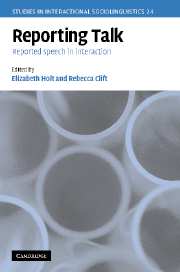Book contents
- Frontmatter
- Contents
- List of contributors
- Acknowledgements
- Transcription conventions
- 1 Introduction
- 2 Interactive Footing
- 3 ‘I'm eyeing your chop up mind’: reporting and enacting
- 4 Assessing and accounting
- 5 Getting there first: non-narrative reported speech in interaction
- 6 Reported thought in complaint stories
- 7 Designing contexts for reporting tactical talk
- 8 Active voicing in court
- 9 Speaking on behalf of the public in broadcast news interviews
- 10 The dead in the service of the living
- References
- Index
2 - Interactive Footing
Published online by Cambridge University Press: 22 September 2009
- Frontmatter
- Contents
- List of contributors
- Acknowledgements
- Transcription conventions
- 1 Introduction
- 2 Interactive Footing
- 3 ‘I'm eyeing your chop up mind’: reporting and enacting
- 4 Assessing and accounting
- 5 Getting there first: non-narrative reported speech in interaction
- 6 Reported thought in complaint stories
- 7 Designing contexts for reporting tactical talk
- 8 Active voicing in court
- 9 Speaking on behalf of the public in broadcast news interviews
- 10 The dead in the service of the living
- References
- Index
Summary
Introduction
In 1929, V. N. Volosinov (1973) argued that the linguistics of his time was seriously flawed because it took as its primary object of study language structures that were isolated from both context and the social life of their speakers. He proposed that this situation could be remedied by focusing on reported speech, utterances in which the current speaker in some way quotes or reports the talk of another. Noting that ‘what is expressed in the forms employed for reporting speech is an active relation of one message to another’, Volosinov (1973: 116, italics in original) proposed that reported speech constituted a crucial site for recovering the intrinsic dialogic organisation of language. The cogency and power of this argument is well demonstrated by the large body of significant research on both reported speech and the dialogic organisation of language and culture that has flourished since the 1970s in a number of different fields.
In reported speech the voices of separate actors are found in a particular place, a complex strip of talk produced by a single speaker, albeit one quoting the talk of another. While recognising both the originality and the importance of Volosinov's insights, I will argue here that the precise way in which he conceptualised reported speech actually served to hide, and render invisible to analysis, crucial aspects of the very dialogic organisation of language that he sought to probe.
- Type
- Chapter
- Information
- Reporting TalkReported Speech in Interaction, pp. 16 - 46Publisher: Cambridge University PressPrint publication year: 2006
- 31
- Cited by



